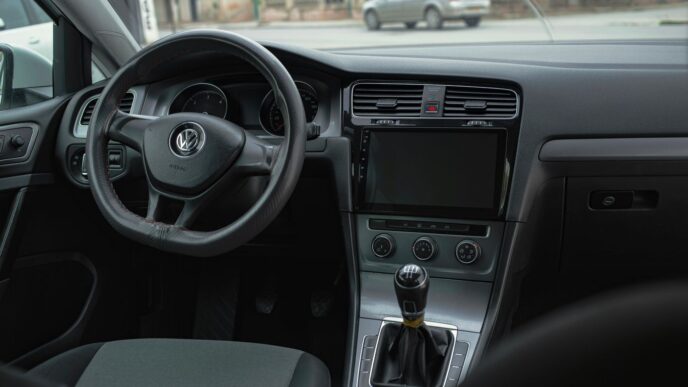So, you’ve got a Tesla, or maybe you’re thinking about getting one. That’s cool! One thing a lot of folks wonder about is how long these cars actually last, especially the battery. It’s a big question, and it makes sense to ask. We’re going to break down the whole tesla life span thing, from how those batteries work to what you can do to keep your car running great for a long time. No fancy talk, just straight facts to help you out.
Key Takeaways
- Tesla batteries are built to last, but they do lose some capacity over time, just like any battery.
- You can really help your battery stay healthy by charging it smart and watching how you drive.
- Tesla’s warranty covers a good chunk of time, making sure your battery stays above 70% capacity.
- Real-world data shows Teslas hold their range pretty well, with only a small drop each year.
- Regular check-ups and basic care, like keeping your tires good, help your Tesla perform its best.
Understanding Tesla Battery Longevity
The Science Behind Lithium-Ion Batteries
So, you’ve got a Tesla, right? And you’re probably wondering how long that fancy battery is actually going to last. It’s a fair question, especially since it’s a big part of what makes these cars tick. At its core, a Tesla battery is a big collection of lithium-ion cells, similar to what’s in your phone, just way bigger. These batteries work by moving lithium ions between a positive electrode and a negative electrode. When you charge up, the ions move one way; when you discharge (drive), they move the other way. It’s a pretty clever system, but like all good things, it doesn’t last forever. Over time, these chemical reactions aren’t quite as efficient, and that’s where degradation comes in. Things like heat and how often you charge to 100% can mess with these delicate chemical processes, making the battery less effective. The key to a long-lasting battery is understanding these internal workings and treating them right.
Real-World Battery Degradation Trends
Now, let’s talk about what actually happens out on the road. You might hear all sorts of numbers thrown around, but generally, Tesla batteries hold up pretty well. They don’t just suddenly drop dead. Instead, they slowly lose a bit of their capacity over time. Think of it like a phone battery that used to last all day but now needs a top-up by late afternoon. For Teslas, the biggest drop in capacity usually happens early on, within the first 50,000 miles or so. After that initial dip, the degradation tends to slow down and become more gradual. It’s not a straight line down; it’s more of a curve that flattens out. Some folks have even seen their Teslas go hundreds of thousands of miles with plenty of usable range left. It really depends on how the car’s been used and cared for. For example, EV battery longevity is often tied to consistent, moderate usage.
Here’s a general idea of what you might expect:
- Initial Degradation: Around 5% loss in the first 50,000 miles.
- Long-Term Trend: Slower, more linear degradation after the initial period.
- Overall Retention: Many Teslas retain 85-90% of their original capacity after 200,000 miles.
Factors Influencing Battery Health
So, what makes some Tesla batteries last longer than others? A few things play a big role. First off, temperature is a huge one. Extreme heat or cold can stress the battery and speed up degradation. That’s why Teslas have sophisticated thermal management systems to keep the battery at an optimal temperature. Second, how you charge matters. Constantly charging to 100% or letting the battery sit at very low states of charge can be tough on it. It’s generally better to keep your daily charge between 20% and 80%. Third, your driving style can have an impact. Frequent, aggressive acceleration and braking put more strain on the battery than smooth, consistent driving. Lastly, the age of the battery itself, regardless of use, contributes to some degradation. It’s just the nature of the chemistry. So, if you want your Tesla battery to go the distance, being mindful of these factors is a good start.
Maximizing Your Tesla’s Battery Life

Keeping your Tesla’s battery healthy is a big deal for its long-term performance and how much range you get. It’s not just about avoiding big problems; it’s about getting the most out of your car every day. Think of it like taking care of yourself – little habits make a huge difference over time. There are some pretty straightforward things you can do to make sure your battery stays in tip-top shape for years to come.
Optimal Charging Practices
Charging your Tesla correctly is probably the most important thing you can do for its battery. It’s not just about plugging it in; it’s about how often, how much, and when. Avoiding extreme charge levels, both too high and too low, is key to preserving battery health.
- Daily Charging Range: For everyday driving, try to keep your battery charged between 20% and 80%. This range puts the least stress on the battery cells. Only charge to 100% when you absolutely need the full range for a long trip, and try to start driving soon after it reaches full.
- Regular, Slower Charging: "Opportunity charging" is your friend. Instead of letting the battery drain really low and then fast-charging it all the way up, plug it in whenever you can, even for short periods. Slower charging, like using a Level 2 charger at home, is much gentler on the battery than frequent Supercharging.
- Minimize Supercharging: While Superchargers are super convenient for road trips, they generate a lot of heat and put more strain on the battery. Use them when necessary, but don’t rely on them for your daily charging needs. Think of them as a treat, not a regular meal.
Impact of Driving Habits
How you drive your Tesla also plays a role in battery longevity. It’s not just about saving energy; it’s about reducing stress on the battery.
- Smooth Acceleration and Braking: Aggressive driving, like sudden acceleration and hard braking, makes the battery work harder and generates more heat. Driving smoothly, with gradual acceleration and using regenerative braking effectively, helps keep the battery cooler and happier. Regenerative braking is a fantastic feature that puts energy back into the battery, which is a win-win.
- Avoid High Speeds: Driving at very high speeds uses a lot more energy and can heat up the battery. While Teslas are built for performance, consistently pushing them to their limits can contribute to faster degradation. Cruising at moderate speeds is better for the battery and your range.
- Preconditioning: If your Tesla has a preconditioning feature, use it, especially in extreme temperatures. This gets the battery to an optimal operating temperature before you start driving, reducing the initial stress on the cells.
Environmental Considerations for Battery Care
The environment your Tesla operates in can also affect its battery life. Extreme temperatures are particularly tough on lithium-ion batteries.
- Temperature Management: Batteries prefer moderate temperatures. Leaving your Tesla parked in direct sunlight in very hot climates or in freezing cold for extended periods can impact battery health. If possible, park in a garage or shaded area. Tesla’s thermal management system does a lot of work, but helping it out is always a good idea. For example, using the energy efficient motor can help with overall system efficiency.
- Long-Term Storage: If you’re going to store your Tesla for a while, aim for a charge level around 50-60%. Don’t leave it at 100% or 0% for long periods. If you can, keep it plugged in to a low-power charger to prevent "vampire drain" and maintain the optimal charge level.
- Software Updates: Always keep your Tesla’s software updated. Tesla frequently releases updates that include improvements to battery management algorithms, which can help optimize battery health and efficiency. These updates are designed to get the most out of your car’s systems.
Tesla’s Battery Warranty Explained
Warranty Coverage Details
So, you’ve got a Tesla, and you’re probably wondering about the battery warranty. It’s a pretty important thing to understand, especially with how much these batteries cost. Generally, Tesla’s battery warranty covers your car for eight years or a certain mileage, whichever comes first. The exact mileage can vary a bit depending on the model. For instance, some rear-wheel-drive Model 3 and Model Y vehicles might have a warranty for eight years or 100,000 miles (about 160,000 km), while other models, like the Long Range or Performance versions, often get eight years or 120,000 miles (around 192,000 km). This warranty is designed to give owners peace of mind regarding the most expensive component of their electric vehicle. It’s not just about manufacturing defects; it also covers significant degradation of the battery’s capacity. It’s worth noting that this warranty is pretty standard across the EV industry, but Tesla’s specific terms are what you need to pay attention to. You can always check your specific vehicle’s warranty details in your Tesla account or owner’s manual.
Understanding the 70 Percent Capacity Benchmark
This 70 percent capacity benchmark is a big deal when it comes to Tesla’s battery warranty. What it means is that Tesla guarantees your battery will retain at least 70 percent of its original capacity during the warranty period. If your battery’s capacity drops below this threshold before the warranty expires, Tesla will replace or repair it at no cost to you. This benchmark is important because once a battery falls below 70 percent, you’ll likely start noticing some real-world impacts on your driving experience. Things like:
- Reduced range: Your car won’t go as far on a full charge as it used to.
- Slower charging times: It might take longer to charge your battery, especially at Superchargers.
- Decreased performance: You might notice a slight dip in acceleration or overall power.
This 70 percent mark is a common industry standard for battery warranties, and it’s a good indicator of when a battery is truly showing significant wear. It’s not just about the battery failing completely; it’s about maintaining a usable level of performance for the owner. For more on how these batteries are evolving, check out electric vehicle batteries.
Implications of Warranty for Owners
For owners, the battery warranty has some pretty clear implications. First off, it protects you from the huge cost of a battery replacement, which can be tens of thousands of dollars. Knowing you have that safety net for eight years or up to 120,000 miles is a big relief. It also means that if you’re buying a used Tesla, checking the remaining warranty period is a smart move. A car with a few years left on its battery warranty is generally a safer bet. However, it’s not a free pass to neglect your battery. While the warranty covers significant degradation, it doesn’t cover damage from misuse or accidents. So, things like:
- Following recommended charging practices (avoiding constant 100% charging or letting it drop to 0%).
- Minimizing exposure to extreme temperatures.
- Adhering to regular service intervals.
These practices still matter for keeping your battery healthy and ensuring you don’t accidentally void any part of your warranty. The warranty is there for peace of mind, but good habits are still your best friend for long-term battery health.
Real-World Tesla Range Expectations
When you buy a Tesla, or any electric car for that matter, one of the big questions is always about how far it’ll actually go over time. It’s not just about the range it has when it’s new, but what you can expect years down the road. Luckily, because Tesla has been around for a while and sold a lot of cars, there’s a good amount of real-world data out there to give us some answers.
Average Annual Range Loss
It’s pretty normal for any battery to lose a little bit of its capacity over time, and Tesla batteries are no different. What’s interesting is how consistent this loss seems to be. Data from thousands of owners shows that Tesla vehicles typically lose about 1% of their original range each year. This isn’t a sudden drop; it’s a gradual decline that most owners barely notice day-to-day. Think of it like this:
- Year 1: 1% loss
- Year 2: Another 1% loss (total 2% from original)
- Year 3: Yet another 1% loss (total 3% from original)
This slow, steady degradation means your car’s range won’t just fall off a cliff. It’s a predictable pattern that helps you plan for the long haul.
Long-Term Range Retention Projections
Given that average annual loss, we can make some pretty good projections about how much range your Tesla will retain over many years. For most owners, the expectation is that your battery will hold onto a significant portion of its original capacity for a long time. For example:
- After 5 years, you’re likely to have around 95% of your original range.
- After 10 years, it’s projected to be over 90% of the original range.
- Even beyond 10 years, many vehicles are still performing well above 80% of their initial range.
This kind of long-term retention is a big deal for electric vehicle ownership, making them a more viable option for many people. If you’re thinking about an extended car warranty for your Tesla, understanding these long-term projections can help you decide if it’s the right choice for you.
Data-Driven Insights from Owners
The best part about Tesla’s longevity is that it’s not just theoretical; it’s backed up by tons of real-world data from owners. People who use their Teslas every day, for hundreds of thousands of miles, are providing the proof. We’ve seen examples of Tesla taxis racking up half a million miles with their original batteries still going strong. This kind of anecdotal evidence, combined with large-scale data analysis, paints a very positive picture for the lifespan of these vehicles. It shows that with proper care, your Tesla can be a reliable ride for many, many years.
General Maintenance for Your Tesla
Owning a Tesla is a bit different from owning a traditional gas car, especially when it comes to upkeep. You might think electric cars don’t need much, but that’s not entirely true. While you skip oil changes and spark plugs, there are still important things to keep an eye on to make sure your Tesla runs smoothly for years. It’s all about being proactive.
Importance of Regular Servicing
Even without an internal combustion engine, Teslas still benefit from regular check-ups. These aren’t your grandpa’s tune-ups, though. We’re talking about things like brake fluid checks, cabin air filter replacements, and making sure all the software is up to date. Ignoring these smaller items can lead to bigger, more expensive problems down the road. Think of it like going to the doctor for a check-up even when you feel fine; it’s about preventing issues before they start. Tesla’s service centers are equipped to handle these specific needs, and they can also diagnose any unusual noises or behaviors your car might be exhibiting. It’s a good idea to follow their recommended service intervals, which you can usually find in your owner’s manual or through the Tesla app. Staying on top of these things helps maintain the car’s performance and its resale value.
Tire Care and Its Effect on Efficiency
Your tires are super important for your Tesla’s efficiency and safety. Because Teslas are heavy and have instant torque, their tires can wear out faster than those on a regular car. Proper tire care isn’t just about avoiding flats; it directly impacts your range and how the car handles.
Here’s what you should be doing:
- Regularly check tire pressure: Under-inflated tires increase rolling resistance, which means your car has to work harder and uses more energy. Check them at least once a month, or more often if you notice a change in temperature.
- Rotate your tires: This helps ensure even wear across all four tires, extending their lifespan. Tesla usually recommends rotations every 6,250 miles or so, but check your specific model’s guidelines.
- Monitor tread depth: Worn-out tires reduce grip, especially in wet conditions, and can affect braking distance. Replace them when the tread gets too low.
Good tire maintenance can really make a difference in how far your Tesla can go on a single charge and how safe it feels on the road. It’s a simple thing that pays off big time.
Other Key Maintenance Areas
Beyond the big stuff, there are a few other areas that need attention to keep your Tesla in top shape. These might seem minor, but they contribute to the overall health and longevity of your vehicle. For instance, the advanced automobile technologies in Teslas mean some components are different from traditional cars.
- Wiper blades: These seem small, but clear visibility is non-negotiable. Replace them when they start streaking or chattering.
- Brake system: While regenerative braking means your physical brakes aren’t used as much as in a gas car, they still need inspection. Brake fluid should be checked, and pads and rotors should be inspected for wear, especially if you live in an area with a lot of stop-and-go traffic.
- Coolant levels: Your Tesla’s battery and motors rely on a sophisticated cooling system. Make sure coolant levels are maintained according to Tesla’s recommendations. This helps prevent overheating and keeps the battery operating at its optimal temperature.
- Software updates: Tesla pushes over-the-air software updates pretty regularly. These updates often include performance improvements, new features, and bug fixes. Always install them when available; they’re like free upgrades for your car.
Conclusion
So, what’s the big takeaway here? Keeping your Tesla’s battery healthy isn’t rocket science, but it does take a little effort. If you charge it smart, drive it smart, and just generally take care of it, you’ll get a lot of good years out of that battery. It’s all about those small habits adding up to a long, happy life for your car. And who doesn’t want that?
Frequently Asked Questions
How do Tesla batteries work and why do they lose power over time?
Tesla batteries are made of many tiny cells, similar to very small power packs. These cells have parts inside that let electricity flow. As you use and charge your car, these parts change a little bit, which can make the battery hold less power over a long time.
What’s the typical amount of battery power loss for a Tesla?
Most Tesla owners find their battery loses about 5% of its ability to hold a charge after the first 50,000 miles. After that, the loss slows down a lot. How well you take care of your battery really matters for how long it stays strong.
What are some simple ways to make my Tesla’s battery last longer?
You can help your battery last longer by not always charging it to 100% or letting it go completely empty. Try to keep it between 20% and 80% charged. Also, avoid really fast charging all the time, as that can be harder on the battery.
What does Tesla’s battery warranty cover?
Tesla guarantees its batteries for 8 years or a certain number of miles, depending on the model. For example, some models are covered for 8 years or 100,000 miles. During this time, they promise the battery will keep at least 70% of its original power.
Why is the 70% battery capacity benchmark important for Tesla owners?
The 70% mark is important because if your battery goes below that, you might notice it doesn’t go as far or takes longer to charge. If this happens while your car is still under warranty, Tesla will replace the battery for free.
How much range can I expect my Tesla to lose each year?
Studies show that Teslas usually lose about 1% of their range each year. This means that even after 10 years, most Teslas should still be able to go over 80% of the distance they could when they were new.














